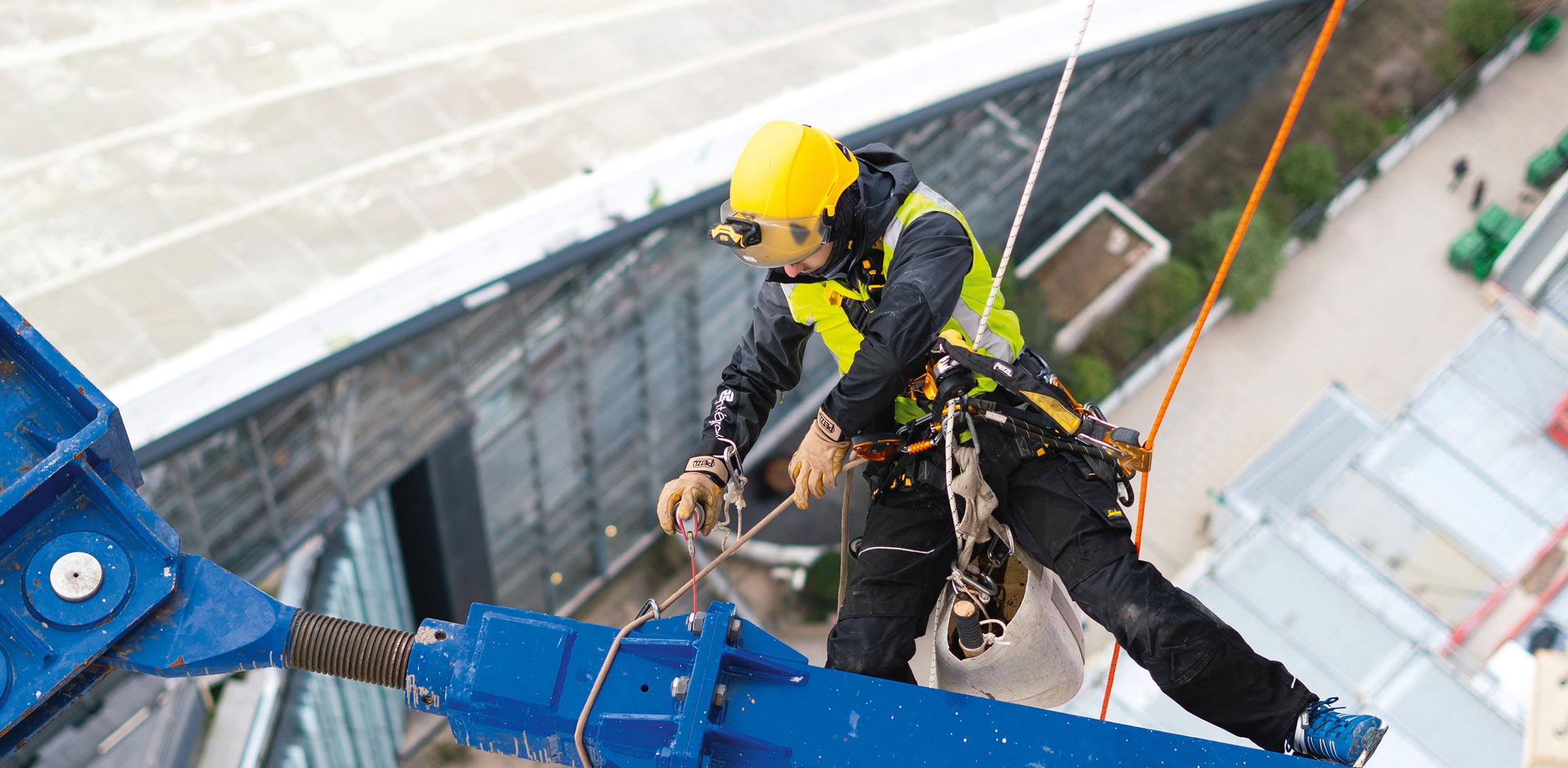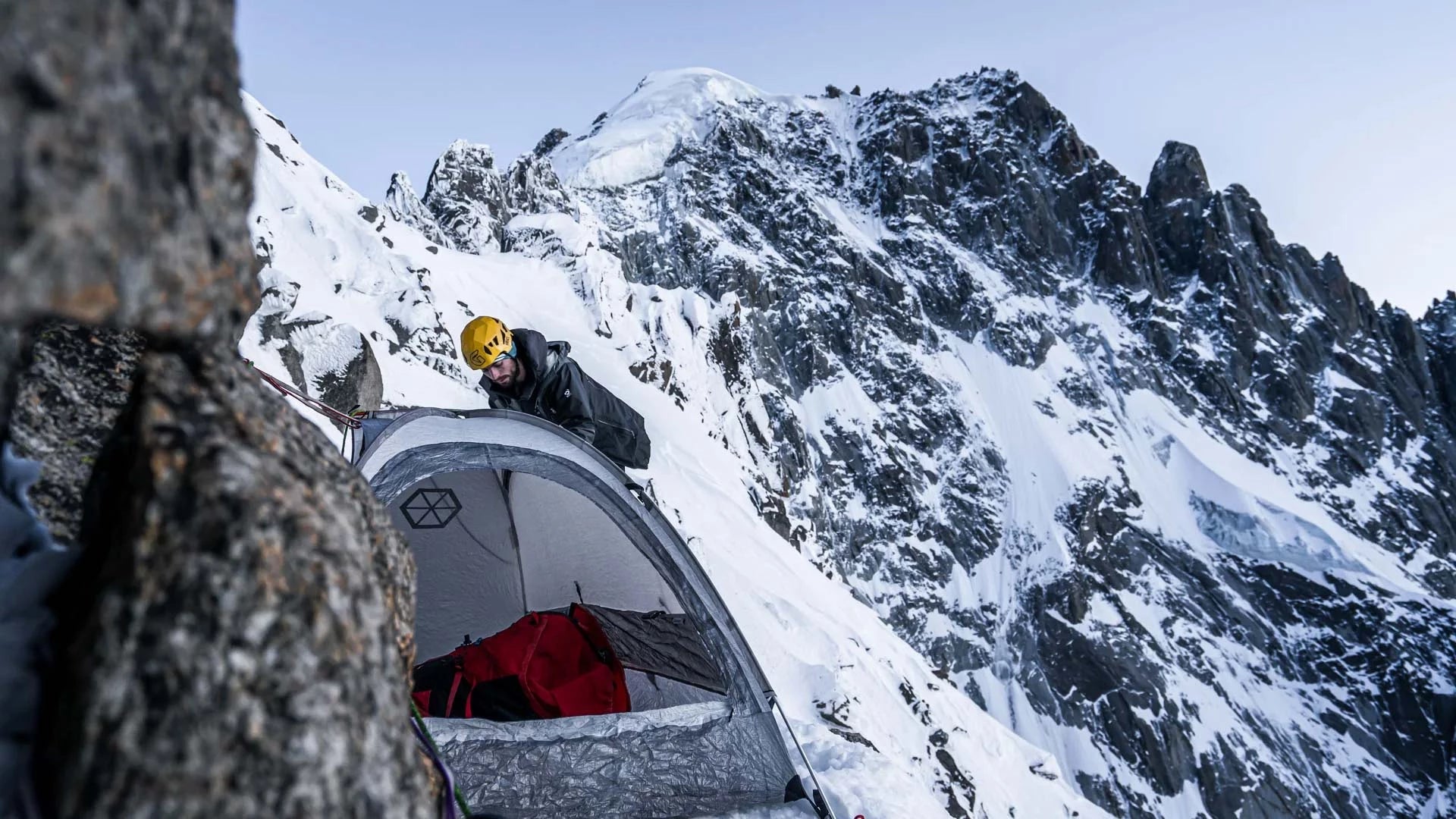A rock climbing helmet is one of the most essential pieces of protective gear for any climber, shielding the head from falling debris, unexpected impacts, and some even protect side blows in case of a fall. Over the years, helmet technology has evolved significantly, making them lighter, stronger, and more comfortable for all types of roped climbing—from trad and sport climbing to alpine and ice climbing. With modern advancements in materials and design, today's climbers can choose from a variety of helmets that balance weight, durability, and affordability while meeting strict safety standards.
2025 saw the release and improvement of many helmet models. We picked six of our favourites and compared them for you. If you want a full in in-depth breakdown of helmet plastics, foams, styles and more read our Helmet Buying Guide.
All modern climbing helmets must meet safety standards set by the UIAA (International Climbing and Mountaineering Federation) and EN (European Norm) certifications. Early climbing helmets were made of leather, offering minimal protection. In the 1950s, fibreglass and plastic hard hats began to replace leather, greatly improving head protection. The introduction of the iconic HB fibreglass helmet marked a significant advancement. Later, foam technology was incorporated into helmets, providing added impact absorption and further enhancing safety. This development led to lighter, more comfortable helmets that offered superior protection against falls and falling debris. Fast forward to today, and modern climbing helmets have evolved much further, combining advanced materials and cutting-edge design for maximum protection and comfort. In this review, we'll take a closer look at some of the top climbing helmets on the market today, highlighting their innovative features and performance.
"Brains are neat, so keep them sweet.”
Note: At Climb On Equipment, our expert team—climbers, athletes, guides, skiers, and mountain rescuers—carefully selects and independently reviews products to help you make informed decisions. Our reviews are not sponsored, so you'll always get our honest take—whether we love a feature or think it falls short.
Helmet Comparison
 |
 |
 |
 |
 |
 |
|
|---|---|---|---|---|---|---|
| Brand & Model | Petzl Sirocco | Edelrid Salathe Lite | CAMP Ikon | Mammut Wall Rider MIPS | Black Diamond Capitan E | Wild County Session |
| Price* (CAD) | $154.95 | $159.95 | $89.95 | $179.95 | $84.95 | $129.95 |
| Summary | A premium ultralight climbing helmet designed for alpinists, sport climbers, and mountaineers who prioritize weight savings. It's a staff favourite if you like the look of side impact protection. | A streamlined, ultralight climbing helmet designed for climbers who want maximum protection with minimal weight. A lighter version of the Salathe, swapping out the original ABS shell for a polycarbonate exterior cap. | A modern, well-rounded climbing helmet that combines the durability of hardshell designs with the comfort and protection of in-mold construction. The Ikon balances weight, ventilation, and safety. | A pioneering helmet that integrates Multi-directional Impact Protection System (MIPS) technology, to enhance safety by reducing rotational forces combined with a lightweight design. | An ultra-durable helmet with enhanced side and back protection, a comfortable fit, and ample ventilation for all-day wear. Made with 30% recycled materials. | A well-designed, lightweight, and highly versatile helmet suitable for a range of climbing. It delivers solid impact protection without excess weight and an ergonomic design, ventilation, and a fully adjustable fit system. |
| Weight | 160g (S/M) 170g (M/L) |
178g (S) 192g (L) |
280g (S/M) 295g (M/L) |
225g (S/M) 250g (M/L) |
320g (S/M) 355g (M/L) |
200g (S/M) 220g (M/L) |
| Pros |
|
|
|
|
|
|
| Cons |
|
|
|
|
|
Not the lightest in its class |
| Certifications* see section below for more info |
CE EN 12492, UIAA 106 | EN 12492, PCSR-002 11.2019. CE-certified as a ski touring helmet in accordance with PCSR-002 11.2019 | EN 12492, UIAA 106 | EN 12492 | EN 12492 + proposed UIAA increased side back protection requirements | EN 12492 + proposed UIAA increased side back protection requirements. |
|
Materials & Construction Read our Helmet buying guide for more info |
Expanded polypropylene (EPP) foam shell, with EPS (Expanded Polystyrene) & polycarbonate crown. | EPP core (expanded polypropylene) with a Curv®, thermoplastic material crown. | Molded inner structure combines EPP main structure with an EPS top and ABS shell. | EPP (Expanded Polypropylene) core with a partial hard shell for maximum safety. | EPP (Expanded Polypropylene) + EPS (Expanded Polystyrene) + 2-piece recycled and DuraPET shell combo. | Hybrid EPP (Expanded polypropylene), EPS (Expanded Polystyrene) & PC (Polycarbonate) top construction. |
*CAD prices listed in this article are subject to change.
Detailed Overview
Below, we provide a more detailed insight into six of the top helmets on the market for 2025—the Petzl Sirocco, Edelrid Salathe Lite, Mammut Wall Rider MIPS, CAMP Ikon, Black Diamond Capitan E, and Wild Country Session—to help you determine the best option for your climbing needs. The technology and standards of helmets have come so far that purchasing any of these helmets would be mind-blowing for a 1990s climber. If you want to dive into the details, below is a breakdown for those gear geeks who love the nuances between amazing products.
Petzl Sirocco - The Ultralight Leader for Fast and Light Climbers
The Petzl Sirocco is one of the lightest helmets on the market, designed for alpine climbers, fast-and-light mountaineers, and sport climbers who want minimal weight on their heads. At 160g (S/M) to 170g (M/L), it's almost half the weight of other helmets, making it ideal for long routes where every gram counts. The helmet is constructed primarily from EPP foam, which is known for its lightweight and impact-absorbing properties. Additionally there is a section of EPS (Expanded Polystyrene) on top and then reinforced with a thin polycarbonate shell to improve resistance against falling debris.
While the Sirocco excels in weight savings, it does come with some trade-offs in durability and protection. Unlike hybrid-shell helmets, which have an outer ABS or polycarbonate shell for added toughness, the EPP foam of the Sirocco is exposed, making it more prone to dents and cosmetic damage over time. The Sirocco meets UIAA and EN 12492 safety standards, and also offers side impact protection to an internal Petzl standard of around 10kn.
Comfort is another area where the Sirocco shines. The helmet has excellent ventilation, with large vents that allow for maximum airflow. The adjustable harness and suspension system ensure a secure fit without pressure points, and the headlamp clips are a great addition for alpine starts or nighttime climbing. The Sirocco's buckle system has been updated to a simple buckle closure without the magnet system of the previous version, which makes one-handed connection quick and easy.
For climbers who focus on weight savings over durability, the Sirocco is an excellent choice. However, if you climb in environments where rockfall, frequent impacts, or long-term durability are concerns, you may want to consider a tougher helmet with a durable ABS shell.

Edelrid Salathe Lite - A Balanced Lightweight Option
The Edelrid Salathe Lite is an excellent midpoint between ultralight and full-coverage helmets, offering lightweight performance without sacrificing durability. Weighing in at 178g (s) & 192g (l), it's only slightly heavier than the Petzl Sirocco. Unlike the original Edelrid Salathe, which had an ABS shell, the Lite version uses a top and front ultra-light Curv material shell, cutting weight while retaining strength.
The Salathe Lite features an EPP foam construction. Expanded polypropylene is used for outstanding shock absorption and high dimensional stability. The ventilation cutouts are well-placed, ensuring good airflow during high-exertion activities. Additionally, this helmet is CE-certified as a ski touring helmet in accordance with PCSR-002 11.2019 (please note: it does not meet the requirements of the EN 1077 standard for ski helmets).
Comfort and fit are well-thought-out in the Salathe Lite. The ergonomic design provides a snug, streamlined profile, and the adjustable strap system ensures a secure fit. Like many modern helmets, it includes headlamp clips for nighttime or alpine climbing. Additionally, the padding is removable and washable, which is a useful feature for climbers who sweat a lot or frequently climb in warm conditions.
While the Salathe Lite is an excellent all-around choice, it lacks some of the enhanced side and rear protection found in more rugged helmets like the Capitan E or Wall Rider MIPS. For climbers who want a balance between weight, durability, and protection, the Salathe Lite is a strong contender, but those who prioritize full-coverage safety may want to consider other options.

CAMP Ikon - A Well-Ventilated, Durable All-Rounder
The CAMP Ikon is an excellent all-purpose helmet, designed for climbers who need a balance of protection, ventilation, and affordability. With a hybrid EPP and EPS foam construction, the Ikon provides a ABS durable shell that can withstand repeated use while still offering strong impact absorption. Unlike pure foam helmets that may dent easily over time, the rigid ABS shell ensures longevity, making it a great option for climbers who frequently encounter rough terrain, gear transportation, or occasional impacts.
One of the standout features of the CAMP Ikon is its ventilation system. With 18 strategically placed air vents, the helmet ensures maximum breathability, making it a strong choice for warm-weather climbs, high-output sport routes, and long approaches. This ventilation system keeps climbers cooler than many competitors, particularly compared to helmets with fewer or smaller vents. The Ikon components can be disassembled for cleaning or replacement,and to help manage the disposal of the components for recycling at the end of life
At 280g (S/M) to 295g (L/XL), the Ikon is not the lightest helmet on the market, but it still remains relatively lightweight for a durable hybrid helmet. The adjustable suspension system ensures a comfortable fit, and removable padding adds extra cushioning for extended climbs. Like most high-end climbing helmets, the Ikon includes secure headlamp clips, allowing climbers to easily attach a light for nighttime ascents or alpine starts.
The CAMP Ikon is best suited for general rock climbers, sport climbers, and those who want a helmet that balances protection, durability, and affordability. It may not be the lightest option, nor does it have MIPS but it serves as a reliable, well-ventilated, and budget-friendly all-around helmet for a variety of climbing disciplines.

Mammut Wall Rider MIPS - Enhanced Safety with Rotational Impact Protection
The Mammut Wall Rider MIPS is one of the first climbing helmets to integrate MIPS (Multi-directional Impact Protection System) technology, a game-changing feature that reduces rotational forces during an angled impact. This makes it an excellent choice for climbers who prioritize brain protection beyond traditional impact absorption. The helmet features a hybrid EPP (Expanded Polypropylene) and EPS (Expanded Polystyrene) construction, striking a balance between lightweight performance and enhanced safety. Compared to traditional helmets, which only absorb direct impact, the MIPS system helps mitigate the effects of rotational motion, one of the primary causes of concussions in climbing falls.
Despite its advanced safety features, the Wall Rider MIPS remains impressively lightweight at 225g (s/m) 250g (m/l). While slightly heavier than ultralight helmets like the Petzl Sirocco (160g-170g) or the Edelrid Salathe Lite (178g - 192g), it provides more protection, particularly for those tackling alpine routes, trad climbs, or high-risk scenarios with rockfall exposure. The helmet also features a partial plastic hard shell in critical impact zones, adding durability where it's needed most. This hybrid design ensures a balance between weight savings and long-term resilience, making it a great option for those looking for a lightweight yet protective helmet.
Ventilation is another strong point of the Wall Rider MIPS. The large side vents help keep air flowing, ensuring comfort on hot, demanding climbs. Additionally, the helmet includes integrated headlamp clips, a must-have feature for early alpine starts and late descents. The padding inside the helmet is removable and washable, ensuring hygiene and long-term comfort for frequent climbers.
While the Wall Rider MIPS stands out as one of the safest helmets available, its higher price point may deter budget-conscious climbers. The addition of MIPS technology increases the cost, making it more expensive than traditional helmets. Additionally, though lightweight, it doesn't quite match the featherlight feel of the Sirocco or Salathe Lite. However, for those seeking top-tier safety, advanced impact protection, and a well-balanced lightweight design, the Mammut Wall Rider MIPS is one of the best options on the market.

Black Diamond Capitan E - Built for Maximum Durability and Protection with Recycled Components
The Black Diamond Capitan E is designed for climbers who prioritize durability and impact protection. Unlike ultralight helmets that focus on shaving off grams, the Capitan E provides full-coverage protection, including increased side and back impact absorption, making it a solid choice for trad, alpine, and ice climbers. It meets the UIAA's proposed standards for enhanced protection, setting it apart from many other models. Black Diamond achieves this by integrating EPS foam on the top for hard impacts and EPP foam on the sides for increased durability, all enclosed within a tough Recycled DuraPET outer shell.
Weighing 320g (S/M) to 355g (L/XL), the Capitan E is heavier than many ultralight helmets, but this added weight brings improved longevity and a lower price point. Many climbers find that lighter helmets get dented easily over time, while the Capitan E is built to withstand repeated use in rugged environments. (The “E” stands for environment) The 30% recycled material construction is a great step toward sustainability, offering an eco-friendly alternative without compromising strength. This is particularly beneficial for climbers who spend a lot of time outdoors and prefer environmentally conscious gear.
Ventilation is another strong point of the Capitan E. The strategically placed vents provide airflow, helping to keep your head cool on long approaches and warm-weather climbs. A low-profile suspension system ensures a snug fit, and removable, moisture-wicking padding adds comfort for extended wear. Combined with integrated headlamp clips, this helmet is well-equipped for pre-dawn starts, long multi-pitch routes, and alpine missions.
While the Capitan E is one of the most durable helmets in its class, it may not be the best choice for climbers who value ultralight performance. Compared to the Petzl Sirocco (160-170g) or Edelrid Salathe Lite (178g - 192g), it is almost twice as heavy. However, if durability, increased coverage, and long-term protection are your top priorities, this is one of the best all-around helmets available.

Wild Country Session - A Versatile and Comfortable Hybrid Helmet
The Wild Country Session helmet is designed for climbers who need an affordable, lightweight, and comfortable option that can handle multiple climbing styles. Its hybrid construction features an EPP (Expanded Polypropylene) core with an EPS (Expanded Polystyrene) impact zone, topped with a hard polycarbonate (PC) shell. This design provides enhanced protection in key impact areas while keeping the overall weight relatively low at 200g (S/M) and 220g (L/XL). Unlike full foam helmets that tend to dent easily, the polycarbonate shell adds durability, making it a solid choice for both sport and trad climbing.
One of the Session's best features is its fit and ventilation. The helmet's ergonomic shape ensures a streamlined profile, and large side vents allow for excellent airflow, helping climbers stay cool on warm days or during high-output ascents. Additionally, the adjustable strap system is fully replaceable, meaning climbers can swap it out if it wears down over time—something not all helmets offer. The removable padding is also washable, which is particularly useful for those who frequently climb in hot or humid conditions. The helmet comes in a solid colour, but we especially love the new graphics which are based on the contours of the Chief from Squamish, BC.
Like most modern helmets, the Session securely accommodates all types of headlamps, featuring two clips in the front and an elastic cord in the back. The helmet's front design is specifically shaped to be compatible with sunglasses and goggles, making it a practical option for climbers who tackle glaciated routes, alpine climbs, or ski mountaineering objectives. While it doesn't have MIPS technology or the extreme durability of full hardshell helmets, it still meets UIAA 106 and EN 12492 safety standards, ensuring that it provides reliable protection for all types of climbing.
Overall, the Wild Country Session is a fantastic budget-friendly option for climbers who want a well-rounded, lightweight helmet without spending a premium. It may not have the ultralight weight of the Sirocco or the added rotational protection of the Wall Rider MIPS, but it delivers a solid combination of safety, comfort, light weight, ventilation, and affordability. This makes it ideal for beginners, all-around climbers, and those who want a durable, no-fuss helmet for cragging, multi-pitch climbing, and even ice climbing.

*Certifications
-
The EN 12492 standard specifies safety requirements and testing methods for climbing helmets, ensuring protection during mountaineering and climbing. It covers shock absorption (max force ≤10 kN), penetration resistance (prevents sharp objects from reaching the head), and chinstrap strength (minimum 50 kg strength, max 25 mm elongation). Helmets must also have secure retention systems and adequate ventilation. Testing includes impact absorption (dropping a striker on various helmet areas), penetration resistance (dropping a 3 kg conical striker from 1 meter), and chinstrap strength (evaluating durability under load).
-
The UIAA 106 standard, set by the International Climbing and Mountaineering Federation (UIAA), builds upon EN 12492 by incorporating additional testing for enhanced impact absorption and retention system performance. UIAA 106-certified helmets provide superior protection against falling objects and multi-angle impacts, meeting higher safety benchmarks than the EN standard alone.













Leave a comment